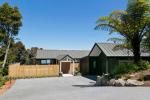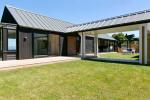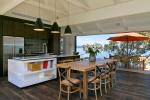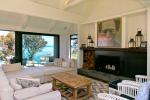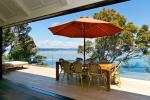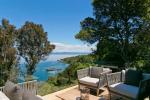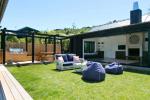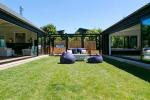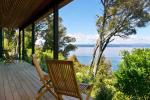Taupo holiday home
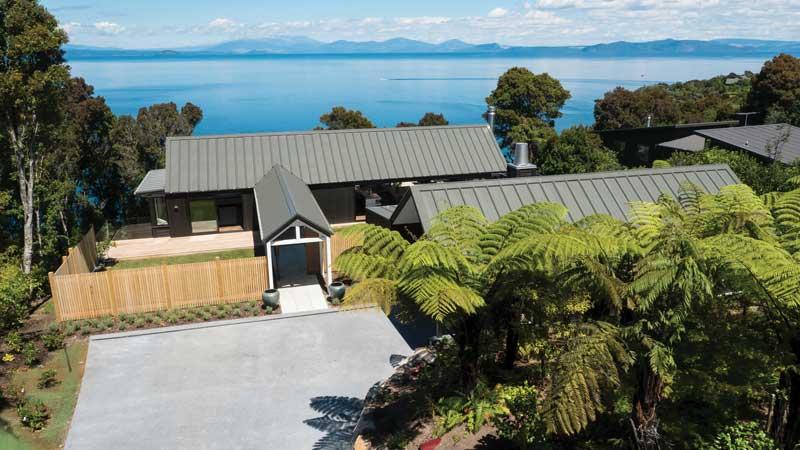
For a young Kiwi/Belgian family living in Hong Kong, having a holiday home on Lake Taupo provides an antidote to apartment living in the fast-paced financial hub.
When Dan Kirton and Sylvie Doclot approached Fraser Cameron Architects, they wanted to build a holiday home on a site at exclusive Whakamoenga Point that could also host extended family and friends from around the world.
Whakamoenga Point overlooks Lake Taupo and is a 24ha gated estate with two private boat ramps, barbecue area, communal club house, tennis court and large tracts of bush reserve and gardens with walkways.
Fraser Cameron says, “We’ve had a long association with the Point and have done a number of enjoyable projects there. Each site has a generous building area and around that is a zone of bush you can’t touch so you end up with a good depth of native bush around the house for shelter and privacy.”
The Hong Kong family’s property is south-facing with views across the lake to the mountains in the distance. For Fraser Cameron that meant designing a home that made the most of those views while bringing in as much sun as possible.
“It’s a fairly typical Lake Taupo problem where you have the views of the lake and the mountains to the south so you have to work out how you can open the house to the view and also open it to sunny and sheltered areas,” says Fraser.
“To achieve this we do a lot of pavilion designs so you can see through the pavilion to the views, and a courtyard or L-shaped design also gives you shelter from the wind.”
Designing a pavilion stretching along the cliff top with stacking sliding glass doors on its southern and northern sides means the views of the lake and mountains can be enjoyed from the sheltered and sunny grassed courtyard on the northern side of the house. When the doors are pushed right back there is an easy flow from the courtyard through the living area of the house and out to the cantilevered deck, which has a glass balustrade for unobstructed views.
Fraser Cameron principal Belinda Ellis adds, “Eaveless roof forms were a deliberate choice for this bush clad site and to maximise sun to the outdoor grass courtyard.”
That grassed space was a must for the Hong Kong family who wanted to feel lawn under their feet. Creating the flat lawn meant building a retaining wall so the area could be levelled.
On the northern side of the lawn, a lanai opens out to the green space via stacking sliders. This large living room was designed as a lean-to off the over height boat garage to break up the bulk of the building and add depth to the courtyard.
The courtyard has a feeling of enclosure as it is flanked by a barbecue area on its western side and, on the eastern side, a covered walkway out to the lanai and garage.
Belinda Ellis says positioning the house was tricky because the waterfront site drops away steeply close to the shore. Because the clients wanted a boat shed and turning circle on flat land, that meant pushing the house as close to the cliff top as possible to provide the necessary space for outdoor living as well.
On the eastern side of the walkway there is another grassed courtyard connected to the house by a deck. This grassed area has potential to be the site of a cottage to provide more accommodation but when that idea was dropped, the lanai – originally conceived as a more informal, open space with shutters - was properly enclosed so that it could serve as overflow accommodation.
By day the lanai is an airy living space but by night it can become a bedroom by virtue of a concealed pull down queen size bed. It also has two day beds, an open fire, fridge and large bathroom making it a self-contained space. Behind it is another bedroom and bathroom.
The top level of the main house has a long open plan kitchen/dining/living space with an exposed gabled roof line. An open fire warms this room, which opens on to the deck overlooking the lake.
At the eastern end on this level is a separate bunk room with window seats along two walls that serve as beds. With a TV in here, the family tends to use it as the children’s rumpus room.
Downstairs, there are three bedrooms each with a private deck with lake views. The master bedroom has a walk in wardrobe, en suite and, on its deck, a large outdoor stone bath and shower. The other two bedrooms share a bathroom.
While the house has been designed for the views, it has also been designed to recede into the landscape to be sympathetic to the unique site.
Fraser says the materials and exterior colours have to meet light reflectance values as set out by the developer rules, which, in this case, are enforced by the local council.
He says the clients had specified Calder Stewart Solar Rib® for the roofing because they liked its Euro tray appearance but it does not come with the associated additional costs of a seam formed roof. The roofing can be coated with Photo-Voltaic Laminate technology to produce solar energy although the clients on this project chose not to harness the sun’s energy.
Belinda says the choice of roof colour was important to tie the home to its site, and was the subject of a lot of consideration.
“The roof colour caused quite a debate with many photos going back and forth between Hong Kong and Taupo. ‘Flint’ was eventually settled on as a ‘green-based’ grey appropriate to the bush setting but still referencing a zinc roof.
The spouting is Roofman 150mm 1/2 Round in Colorcote® Flint along with contrasting stainless steel gutter clips for added detail, a favourite design device of the architect.”
Black aluminium joinery complements the cladding of the house, which is western red cedar painted black. Detail is worked into the black cladding by using two Herman Pacific profiles: a vertical shiplap and a bevel back weatherboard.
Belinda says for the interiors “a slightly edgy palate with a rustic note was carefully selected, befitting of the holiday house use and brief”.
“The clients were quite specific about using plywood lining for the interior walls, and wanting more rugged materials that would suit a young family,” she says.
Oak finished floors and cabinetry continue the rustic theme.
The project received an NZIA Award in 2015. The NZIA jury, led by Camden Cummings, noted the challenging conundrum of views and sun occupying opposite compass points on the site.
“This elongated pavilion, perched on a Taupo cliff edge with a panorama of lake and mountains for company, solves the problem through extensive glazing on two long sides - a manoeuvre that maximises the opportunities for views form the south and north, while providing a sun-welcoming living court that is protected from the cold southerly wind. Serene interiors draw on the boat shed form, emphasising the elegant exposed trusses and utilising to effect a quiet texture-based material palette, all complemented by the skilful use of concealed lighting”.
The house is available to enjoy through airnbnb.co.nz/rooms/5184352
Solar Rib®
Since 1970 Calder Stewart Roofing have been developing innovative products to meet the evolving demands of the New Zealand construction market, supplying specialist materials for everything from woolsheds to industrial warehouses to architecturally designed houses. Solar Rib® is New Zealand’s only roofing profile specifically designed to generate electric power through the use of Photo-Voltaic Laminate (PVL) solar panel technology. An attractive profile offering elegant looks, Solar Rib® can be installed without the PVL, with the laminate being added onto the profile at a later time if desired.

